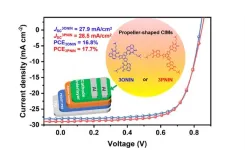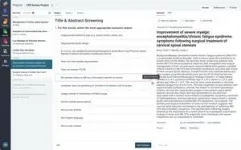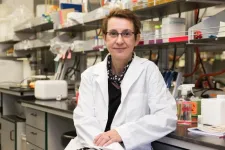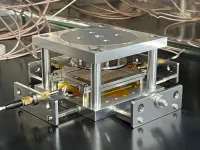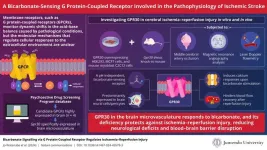(Press-News.org)
Imagine technology as a race car speeding down a track – it can only go as fast as its engine allows. But just when it seemed like organic solar cells hit a roadblock, along comes 3PNIN, a game-changing molecule shaped like a propeller, ready to turbocharge their progress and break through barriers.
Organic solar cells (OSCs) represent the pinnacle of renewable energy, yet certain components have fallen significantly behind the trajectory of ongoing development. Particularly, cathode interfacial materials (CIMs) have failed to sustain the momentum necessary to match the continuous enhancement of OSCs. CIMs play a critical role in facilitating current conduction from the metal to the semiconductor and vice versa; hence, if they fall short in electron-transport performance, the power conversion efficiency (PCE) of OSCs is compromised. In response to this challenge, researchers delved into investigating how molecular structure impacts the overall performance of both the cell and the interfacing materials. Two propeller-shaped compounds exemplify the significant influence that molecular configuration can exert on enhancing the functionality of CIMs and, consequently, the photovoltaic performance of OSCs.
Researchers published their results in Nano Research on February 6.
The study reported two isomers, 3PNIN and 3ONIN, which are molecules sharing the same formula but possessing distinct arrangements of end-capped groups. These varied group arrangements enable different intermolecular interactions to take place within one isomer that may not be achievable with the other.
"In the vast realm of renewable energy, OSCs have ascended to prominence, characterized by their ethereal architecture, semi-transparency, cost-effective production, and scalable printed assembly, heralding a new era in powering flexible wearable technologies," remarked Prof. Minghua Huang, the author and researcher of the study.
The significance of this technology in a world where sustainable energy sources have gained considerable traction (and necessity) cannot be overstated. Upon testing the propeller-shaped isomers presented in this research, results revealed that the two compounds can exert vastly different effects based on their configuration, with one variant outperforming the other in enhancing the functionality of CIMs.
3PNIN exhibits a more planar molecular structure compared to its counterpart, 3ONIN. This structural disparity enables the end-capped groups in 3PNIN to lie flatter relative to 3ONIN, thereby demonstrating significant enhancements in functionality, such as electron mobility and conductivity. “As a result, 3PNIN and 3ONIN-treated OSC devices yield PCEs of 17.73% and 16.82%, respectively,” said Prof. Minghua Huang.
3PNIN displays significant promise in fabricating a thermally stable device while also enhancing PCE of OSCs, in addition to the benefits of improved mobility and conductivity compared to the prevailing technology widely utilized for CIMs. Further refinement of OSC devices treated with the 3PNIN isomer holds the potential to advance the accessibility and efficiency rates of this energy source. Enhancements in OSCs can exert a widespread impact on the renewable energy landscape and may extend to other realms of technology reliant on organic electronics.
Hao Liu, Jilei Jiang, Shuixing Dai, Xianbiao Hou, and Minghua Huang of the School of Materials Science and Engineering at the Ocean University of China, Liangmin Yu from the Open Studio for Marine Corrosion and Protection at the Pilot National Laboratory for Marine Science and Technology, Xu Zhang and Ke Gao of the Science Center for Material Creation and Energy Conversion at the Institute of Frontier and Interdisciplinary Science at Shandong University, and Heqing Jiang of the Qingdao Key Laboratory of Functional Membrane Material and Membrane Technology at the Chinese Academy of Sciences contributed to this research.
The National Natural Science Foundation of China (22105189) supported this research.
About Nano Research
Nano Research is a peer-reviewed, international and interdisciplinary research journal, publishes all aspects of nano science and technology, featured in rapid review and fast publishing, sponsored by Tsinghua University and the Chinese Chemical Society. It offers readers an attractive mix of authoritative and comprehensive reviews and original cutting-edge research papers. After 15 years of development, it has become one of the most influential academic journals in the nano field. In 2023 InCites Journal Citation Reports, Nano Research has an Impact Factor of 9.9, the total cites reached 35645, ranking first in China's international academic journals, and the number of highly cited papers reached 229, ranked among the top 1.5% of 8786 academic journals.
About SciOpen
SciOpen is a professional open access resource for discovery of scientific and technical content published by the Tsinghua University Press and its publishing partners, providing the scholarly publishing community with innovative technology and market-leading capabilities. SciOpen provides end-to-end services across manuscript submission, peer review, content hosting, analytics, and identity management and expert advice to ensure each journal’s development by offering a range of options across all functions as Journal Layout, Production Services, Editorial Services, Marketing and Promotions, Online Functionality, etc. By digitalizing the publishing process, SciOpen widens the reach, deepens the impact, and accelerates the exchange of ideas.
END
BINGHAMTON, N.Y. -- Binghamton University, State University of New York researcher Karin Sauer is among 65 scientists elected as Fellows of the American Academy of Microbiology this year.
Fellows are elected by their peers based on their scientific achievements and original contributions to the field of microbiology.
Sauer’s lab aims to find ways to control communities of bacteria called biofilms and to curb their extraordinary resistance to antimicrobial agents. The team’s findings could have an impact on a wide range of healthcare practices, from ear infections to wound care.
“I’m honored and ...
Archeologists have long used the shapes and styles of pottery as a proxy for ancient cultures. But how does the cultural alignment of ceramic forms arise? To explore this question, Tetsushi Nonaka and colleagues asked 21 potters in three different communities—one in France in Bourgogne and two in India in Bulandshahar district, Uttar Pradesh—to throw pots with the same unfamiliar shapes. One of the Indian pottery workshops was Hindu, the other was Muslim. In each community, several different potters tried the shapes. Through careful measurement, the authors were able to determine ...
A study quantifies the emission of extremely tiny particles by gas stoves and finds that the particles could harm human health. Airborne nanoparticles between 1–3 nm, referred to as nanocluster aerosol or NCA, are known to be bioactive and toxic, but measuring such minute particles has been a challenge. Brandon E. Boor and colleagues measured indoor NCA during propane gas cooking in the Purdue zero Energy Design Guidance for Engineers (zEDGE) test house using a novel instrument. Combining measurement data with the general dynamic equation for aerosols, the authors were able to characterize the production and behavior ...
Continuous research is being conducted globally on using the Moon as an advanced base for deep space exploration, and Korea is no exception in these efforts. The Korea Institute of Civil Engineering and Building Technology (KICT, President Kim, Byung-suk) successfully implemented an electrostatic environment that simulates the Moon's surface conditions, not in space but on Earth. The researchers also assessed its performance and effectiveness.
Among the most serious threats in executing lunar missions is the Moon's surface environment, which is electrostatically charged. Due to its extremely thin atmosphere, the Moon is directly exposed to solar ultraviolet rays, X-rays, ...
In an editorial, Sandro Galea and Gillian Buckley summarize the findings of a National Academies of Sciences, Engineering, and Medicine consensus study report on social media and adolescent mental health. Social media has to some extent been treated as a monolith, but the report finds that different types of engagements with different digital platforms may have very different effects on mental health. In some situations, social media may benefit adolescent mental health, as when LGBTQ+ adolescents in isolating circumstances are able to form supportive ...
Thousands of satellites take pictures, gather information and relay internet traffic from high above the Earth. Now, the challenge is making satellites that operate closer to home, in what is called a very low earth orbit (VLEO), where there is ample space for additional satellites, and the pictures taken would be clearer.
Working at an altitude with air would mean more force would be needed to propel the satellite forward, but many scientists believe there is also an advantage: the air could be used as the propellant. They say charged particles of air-breathing plasma – the fourth state of matter – could be used to propel the thrusters, potentially ...
Research Highlights
Closer proximity to and a higher number of ready-to-eat food outlets — particularly pubs, bars and fast-food restaurants — may be associated with a greater risk of developing heart failure, according to a study of half a million adults in the UK Biobank.
The association between food environments and increased heart failure risk was stronger among people who did not have a college degree and those living in urban areas without access to facilities for physical activity such as gyms or fitness centers.
Embargoed until 4 a.m. CT/5 a.m. ET Tuesday, Feb. 27, 2024
DALLAS, Feb. 27, 2024 — Living close to pubs, bars and fast-food restaurats may ...
Research Highlights:
Women’s heart disease and stroke risks and outcomes differ throughout life in comparison to men.
A special Journal of the American Heart Association “spotlight” issue features a collection of the latest research about sex differences in cardiovascular disease and their implications for gender-specific care.
Among the topics in this issue: the impact of sedentary behavior on heart disease risk in older women; sex differences in the relationship between schizophrenia and the development ...
Cells actively rely on maintaining an appropriate acid-base balance to support optimal function. Under normal physiological settings, the pH inside cells remains within a controlled range. However, disruptions in this equilibrium have been linked to a wide range of health conditions, both minor and catastrophic. Changes in the extracellular environment are monitored by “membrane receptors,” of which the G protein-coupled receptors (GPCRs) are a large family of membrane proteins that mediate multiple cellular responses. However, the role of GPR30, also known as G protein-coupled estrogen ...
Researchers have developed a “self-driving” lab that uses artificial intelligence (AI) and automated systems to provide in-depth analyses of catalytic reactions used in chemical research and manufacturing. The new tool, called Fast-Cat, can provide more information in five days than is possible in six months of conventional testing.
At issue are the yield and selectivity of chemical reactions in the presence of molecules called ligands.
Yield refers to how efficiently a chemical reaction produces a desired product from the chemicals you started with. Selectivity refers ...
